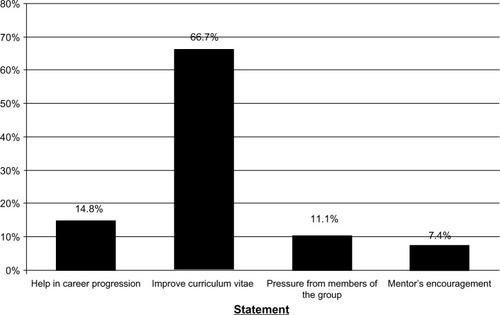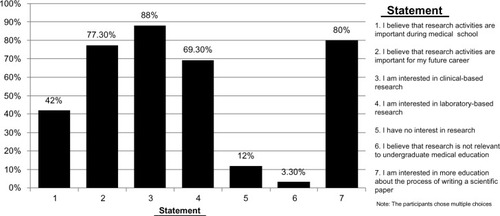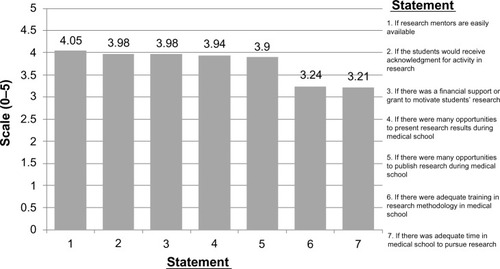Abstract
Background
Research is the foundation of scientific advancement and improvement in quality of health care, which ensures the good health of the community. The aim of this study is to explore experiences, attitudes, and barriers of medical students in Kuwait University (KU) in regards to extracurricular research.
Methods
A questionnaire about extracurricular research activities (ie, any research activity that is not part of the required undergraduate curriculum, such as publishing a paper, research elective, etc) was distributed to 175 senior medical students (years 6 and 7). Descriptive and chi-square analyses were used to analyze the responses, considering a P-value of <0.05 as the cut-off level for significance. The main outcome was defined as taking part in any of the extracurricular research activities.
Results
Of the 150 participants (response rate = 85.7%), 26 (17.3%), 68 (45.3%), 52 (34.7%), and 17 (11.3%) had published their required medical school research, presented abstracts in conferences, conducted extracurricular research, and completed a research elective/course, respectively; 99 (66.0%) took part in any of these activities. Participants who read medical journals regularly (81; 54%) reported higher participation in extracurricular research activities than those who did not read journals (P=0.003). Improving the availability of mentors for students’ extracurricular research was ranked by the participants as the most important factor to improve their participation in extracurricular research (4.05/5.00).
Conclusion
Despite the lack of adequate support, extracurricular research activities among medical students of KU were comparable to students from other countries. Barriers for these activities should be addressed by KU medical educators in order to enhance research activities among the students.
Introduction
Research is imperative in the advancement and improvement of the quality of health care. As such, medical students are required to develop research skills. It has been shown that involvement in research activities allows medical students to gain skills in search methodology, critical appraisal, statistics, time management, and teamwork, thus improving patients’ care.Citation1–Citation5 Moreover, getting involved in research and publishing scientific papers while attending a medical school increases the chances of students getting accepted in highly competitive residency training programs.Citation4,Citation6–Citation8
A large number of medical students have reported that conducting research is challenging; however, interest in a specific field and career advancement were the strongest motivators.Citation9,Citation10 Lack of time and availability of supervisors, a perception that the student would not receive appropriate acknowledgement for effort spent in research activities, and the perception that researchers are isolated from clinical practice were common reasons for not conducting research among medical students.Citation3,Citation10
The Kuwait University (KU) medical curriculum is a 7-year program divided into a 4-year basic and a 3-year clinical sciences program. Evidence-based medicine (EBM) and research skills courses are part of both the basic sciences and clinical phases of the medical curriculum. Medical students start learning the basics of EBM, biostatistics, and epidemiology throughout the basic sciences phase, while they conduct a community medicine (CM) research project during an 8-week period of the clinical phase, with no obligation to publish their research projects. Students form small groups of 4 to 5 students to conduct their research, and the department of Community Medicine and Behavioural Sciences assigns research mentors and assistants to guide the groups throughout the steps of their project. This CM module is the course which exposes the students to research and basic concepts of public health and community medicine.
KU is focusing on the evaluation and improvement of the bedside teaching of their medical students; however, evaluating research and EBM education has not been done before.Citation11–Citation14 In this study, any research experience that was not part of the curriculum in medical school is defined as an extracurricular research activity that includes presenting research abstracts, publishing scientific papers or participating in research electives. Knowledge about the involvement of KU medical students in extracurricular research activities is lacking. Therefore, we aimed to explore the experiences of extracurricular research activities, study the attitude of the senior medical students towards research and publication, and investigate the barriers to acquiring competence in research practices among medical students in KU. The deficiency of research infrastructure that integrates undergraduate medical students in Kuwait suggests that there should be little student participation in extracurricular research activities. This presents an opportunity in comparing such students to their international peers in terms of these activities, aiming to understand if the lack of a support system for students’ research would result in a lower participation in research activities.
Methods
This cross-sectional study conducted during November 2012 included medical students from KU who had completed their research projects (ie, sixth and seventh year medical students). During the academic year 2012/2013, 91 and 95 students were enrolled in the sixth and seventh years of study respectively (a total of 186).
A self-administered questionnaire composed of three main sections was developed based on a comprehensive literature review and was pre-tested on 20 randomly selected students to ensure clarity of questions.Citation2,Citation3,Citation9,Citation10 Section I included 13 multiple choice, closed-ended questions about the sociodemographic characteristics and background information about the student’s research and publication practice. Sections II and III consisted of questions about the student’s attitude towards research and barriers against research practice, containing 11 and 13 questions, respectively. The students had to choose between yes or no for sentences about the attitude toward research, and were asked to rate possible barriers to their participation in extracurricular research activities using a scale ranging from 1 (strongly disagree) to 5 (strongly agree).
Written informed consent was obtained from each participant after proper explanation of the objectives of the study. Participants were assured of the confidentiality of the collected information. They were also assured that there would not be any harm if they declined to participate in the study. The study protocol and data collection instrument were ethically approved by Kuwait Institute for Medical Specialization, and permission to collect data from the students was obtained from the administration of the Faculty of Medicine of KU.
Data were entered and analyzed using Statistical Package for the Social Sciences (SPSS, version 17.0; PASW, SPSS Inc, Chicago, IL, USA). Frequencies and percentages were obtained for all variables to generate descriptive tables and figures. Chi-square analysis was performed to assess the association between students’ participation in extracurricular research activities and their sociodemographic and academic characteristics, to understand if students with different academic performance or personal backgrounds would have different interests in research. A P-value of <0.05 was considered as the cut-off level for statistical significance.
Results
Of 175 students who were approached, 150 (87.5%) agreed to participate in the study while the remaining 25 (14.3%) did not offer any reason for declining. The sociodemographic and academic characteristics of the study sample are given in . Of the 150 participants, 88 (58.7%) were female, 83 (55.3%) aged 23 years or less, and 117 (78.0%) were unmarried. With regard to their academic features, 87 (58.0%) students were in their final year of study, 123 (82.0%) had a grade point average (GPA) of <3.00, 122 (81.3%) scored <80.0% in their CM module, and 79 (52.7%) had not decided a future career specialty, while 71 (47.3%) had made such a decision. Of the 71, 29 (40.8%) preferred a medical future specialty and 53 (74.6%) were planning to complete their postgraduate education/residency outside of Kuwait. Of the 150 participants, 81 (54.0%) students read medical journals regularly (ie, following at least one journal’s issues and updates).
Table 1 Sociodemographic and academic characteristics of medical students in Kuwait University during the academic year 2012/2013
Overall, 99 (66.0%) of the students had participated in extracurricular research activities (). Specifically, 26 (17.3%), 68 (45.3%), 52 (34.7%), and 17 (11.3%) students published their undergraduate research project in a medical journal, presented an abstract in a conference, participated in extracurricular research projects, and received extracurricular research education/training, respectively. The most important reasons reported by the students for publishing their CM research projects () were to improve their curriculum vitae (18; 66.7%), to help in career progression (4; 14.8%), pressure from members of the research project group (3; 11.1%), and the encouragement of their research mentors (2; 7.4%). On the other hand, the most important reasons/barriers for not publishing the CM projects reported by the students () were lack of time due to other commitments or studies (42; 33.9%), lack of interest either by the participant or other members of his/her project group (34; 27.4%), lack of guidance and supervision (20; 16.1%), lack of encouragement from the project’s mentor (15; 12.1%), and lack of knowledge on how to write a scientific article for publication (13; 10.5%).
Figure 1 Reasons for publishing the community medicine research project reported by medical students in Kuwait University during the academic year 2012/2013.

Figure 2 Reasons for not publishing the community medicine research project reported by medical students in Kuwait during the academic year 2012/2013.

Table 2 Extracurricular research activities of medical students in Kuwait University during the academic year 2012/2013
The chi-square analysis of the association between participation in extracurricular research activities and sociodemographic and academic characteristics of the students is shown in . Students who read medical journals regularly were found to have a statistically significant higher participation in extracurricular research activities (P-value 0.003). No other factors were found to be significantly associated with students’ participation in these activities.
Table 3 The association between Kuwait University medical students’ sociodemographic and academic characteristics with the participation in extracurricular research activities during the academic year 2012/2013
The students’ attitude towards research activities is given in . Sixty-three (42.0%) students believed that research is important during undergraduate education, while 116 (77.3%) believed that it will become important during their future career. In addition, 132 (88.0%) reported interest in clinical-based research, while 104 (69.3%) students reported interest in laboratory-based research. On the other hand, 18 (12.0%) students reported no interest in research while 5 (3.3%) students believed that research was not relevant to undergraduate medical education. Of the students surveyed, 120 (80.0%) were interested in additional education and training about the process of writing a scientific paper.
Figure 3 Attitude of medical students in Kuwait University toward research practices and activities during the academic year 2012/2013.

Barriers against students’ participation in extracurricular research activities are shown in . The most important barriers reported by the students that need to be improved so that they can participate more in extracurricular research activities were availability of mentors (score 4.05/5.00), acknowledgement for students’ participation in research (score 3.98/5.00), and availability of financial support or grants for students’ research (score 3.98/5.00).
Discussion
Although the overall participation in extracurricular research activities was high, the findings that the majority of KU medical students did not publish their required undergraduate research project or participate in other extracurricular research activities are similar to some previous studies.Citation15–Citation18 For example, the publication rate of students’ scientific papers was low in Germany and the UK, ranging from 14% to 28%.Citation15,Citation16 Nevertheless, a higher rate of publication (range: 41% to 75%) was noted among students from the USA.Citation17,Citation18 This difference in the rate of publication of students’ research is most probably due to the disparity in the research methodology between the studies; some authors used a questionnaire covering most of the students, while others did a literature search resulting in lower rates of extracurricular research activity.Citation15–Citation17 Also, the medical schools’ curricular differences might contribute to this difference. For example, Stanford University’s School of Medicine provided a good example of successful undergraduate research activities where students were encouraged by funding and teaching staff to conduct research.Citation18 This encouragement resulted in 90% of their students performing research, publications among 75%, and presentations at national meetings among 52%.
The findings of this study that the motivating factors for publishing a paper were mainly to improve the student’s personal curriculum vitae and help in career progression were also noted in a study of UK medical students, where 51% of the students submitted papers for publication to improve their curriculum vitae and 10% to improve their career progression and academia.Citation15 In addition, another study done in the UK revealed that CV improvement was the main motivator for participation in research and audits among 51% of medical students.Citation19 On the other hand, 65% of fourth year Canadian medical students reported that personal interest was their motivation to participate in research activities.Citation10 It is important to point out that based on previous studies, although research and publications increase the chances of getting accepted in residency programs, they are not the most important factors used in selecting residents.Citation6–Citation8 Hence, students’ participation in research should not be motivated mainly by improving their CV.Citation6–Citation8
Challenges to participation in undergraduate medical research were addressed in previous studies.Citation19–Citation21 Availability of research mentors was considered the most important issue that needed to be addressed to improve students’ research among our participants. Additionally, lack of time was the most important reason reported by our students for not publishing papers. This aspect also proved to be an important barrier against conducting research among Brazilian medical students.Citation20 Likewise, medical students in the UK reported time constraints (74%) as the most important obstacle against participation in research and audits, as previously reported.Citation19 Such barriers could be resolved by establishing summer research electives, research interest groups, and providing sufficient time for research activities during the undergraduate medical curriculum.Citation22–Citation24 Research mentorship should also be encouraged among faculty staff, possibly by funding mentors, and the importance of extracurricular students’ research to the publication output of the academic institute should be highlighted.Citation16
In Portugal, male students were twice as likely to participate in extracurricular research activities than females, but this was not the case among our participants; the only sociodemographic or academic characteristic that was found to be associated with participation in extracurricular research activities was reading journal articles regularly.Citation25 The most probable explanation for this association is that students who read scientific papers have better skills in searching the literature, better understanding of the basic steps of writing a research article, and had more interest in academic careers. Nevertheless, being involved in more research activities can be a reason for reading more scientific journals.
Although less than 20% of medical students in KU reported that they are interested in a future specialty that offers more research opportunities, the majority of them reported that research activities were important for their future career.Citation26 Moreover, most of the participants were interested in more education about the process of writing scientific papers, and only 12% reported no interest in research. This interest should be utilized by medical educators and students’ mentors in KU to improve the research activities and productivity of their students.
The major limitations of this study are that it is cross-sectional, questionnaire-based, and self-reported, which can result in recall and responder biases. Also, some of our participants completed their CM course a few months before data collection; hence they might not have had sufficient time to publish their findings.
Conclusion
Despite the lack of adequate support, extracurricular research activities among medical students of KU were comparable to students from other countries. Barriers for these activities should be addressed by KU medical educators in order to enhance research activities among the students.
Disclosure
The authors have no conflicts of interest to declare.
References
- FrishmanWHStudent research projects and theses: should they be a requirement for medical school graduationHeart Dis2001314014411975783
- HouldenRLRajaJBCollierCPClarkAFWuaghJMMedical students’ perceptions of an undergraduate research electiveMed Teach20042665966115763861
- BurgoyneLNO’FlynnSBoylanGBUndergraduate medical research: the student perspectiveMed Educ Online201015
- SeymourEHunterABLaursenSLDeAntoniTEstablishing the benefits of research experiences for undergraduates in the sciences: First findings from a three-year studySci Ed200488493534
- Murdoch-EatonDDrewerySEltonSWhat do medical students understand by research and research skills? Identifying research opportunities within undergraduate projectsMed Teach201032e152e16020218832
- GreenMJonesPThomasJXJrSelection criteria for residency: results of a national program directors surveyAcad Med20098436236719240447
- SinhaSSinhaASinhaSBhanCMcConnachieAKnowlesCHSelection matters-a regional survey of UK consultant opinion on selection into postgraduate surgical and medical trainingJ Surg Educ201067859420656604
- MarwanYAyedASelection criteria of residents for residency programs in KuwaitBMC Med Educ201313423331670
- PruskilSBurgwinkelPGeorgWKeilTKiesslingCMedical students’ attitudes towards science and involvement in research activities: a comparative study with students from a reformed and a traditional curriculumMed Teach200931e254e25919811157
- SiemensDRPunnenSWongJKanjiNA survey on the attitudes towards research in medical schoolBMC Med Educ201010420096112
- KarimJAl-SarajiMAl-MousawiFKnowledge and self-reported practice of universal precautions among Kuwait University medical students in their clinical yearsMed Princ Pract20122132833322248907
- MarwanYAl-SaddiqueMHassanAKarimJAl-SalehMAre medical students accepted by patients in teaching hospitals?Med Educ Online2012171717222509091
- KarimJAMarwanYADawasAMAkhtarSSelf-confidence of medical students in performing clinical skills acquired during their surgical rotation: Assessing clinical skills education in KuwaitSaudi Med J2012331310131623232679
- AlmutarSAltourahLSadeqHKarimJMarwanYMedical and surgical ward rounds in teaching hospitals of Kuwait University: students’ perceptionsAdv Med Educ Pract2013418919324101889
- GriffinMFHindochaSPublication practices of medical students at British medical schools: experience, attitudes and barriers to publishMed Teach201133e1e821182368
- CursiefenCAltunbasAContribution of medical student research to the Medline-indexed publications of a German medical facultyMed Educ1998324394409743810
- DyrbyeLNDavidsonLWCookDAPublications and presentations resulting from required research by students at Mayo Medical School, 1976–2003Acad Med20088360461018520471
- JacobsCDCrossPCThe value of medical student research: the experience at Stanford University School of MedicineMed Educ1995293423468699971
- Nikkar-EsfahaniAJamjoomAAFitzgeraldJEExtracurricular participation in research and audit by medical students: opportunities, obstacles, motivation and outcomesMed Teach201234e317e32422471919
- de OliveiraNALuzMRSaraivaRMAlvesLAStudent views of research training programmes in medical schoolsMed Educ20114574875521649708
- TagalJDifficulties in undergraduate medical researchClin Teach2007425
- ZierKFriedmanESmithLSupportive programs increase medical students’ research interest and productivityJ Investig Med200654201207
- MabvuureNTTwelve tips for introducing students to research and publishing: a medical student’s perspectiveMed Teach20123470570922905656
- Lawson McLeanASaundersCVeluPPIredaleJHorKRussellCDTwelve tips for teachers to encourage student engagement in academic medicineMed Teach20133554955423496123
- SalgueiraACostaPGonçalvesMMagalhãesECostaMJIndividual characteristics and student’s engagement in scientific research: a cross-sectional studyBMC Med Educ2012129523066758
- Al-FouzanRAl-AjlanSMarwanYAl-SalehMFactors affecting future specialty choice among medical students in KuwaitMed Educ Online2012171723272649


